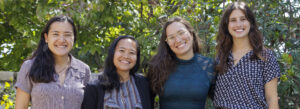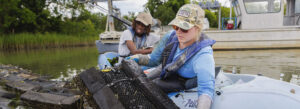AECOM intern ‘soaks up’ resilience engineering experience
Whether it was testing out a new carbon calculator tool or summarizing a client interview, Grace Carter found one thing to be consistent throughout her summer 2019 AECOM resilience internship—exposure to diverse perspectives on resilience.
“From working with FEMA, to local government, to planners, water engineers, and landscape architects at AECOM, I got to experience many steps in the process of resilience,” Carter said.
While Carter was based in AECOM’s Arlington, VA, office, the projects she worked on connected her with a variety of departments and offices within AECOM. During a visit to FEMA headquarters in Washington, D.C., Carter helped consolidate public feedback for a new agency program intended to fund public infrastructure projects that strengthen community resilience before a disaster strikes.
Carter also had an opportunity to test a new carbon calculator on several AECOM projects. This calculator estimates how many years it will take before a landscape architecture project becomes “climate positive,” and stores more carbon than it emits. The tool, currently in beta testing, balances plants’ ability to sequester carbon against the initial carbon footprint of construction. Carter used the calculator to generate estimates for AECOM projects and provided feedback to improve the calculator’s performance.
“It’s still fairly new, which is why they wanted to take a look at it,” said Andrea Sweigart, Associate Principal at AECOM, who supervised the internship. “Carter’s observation and insight will be of great value to the calculator’s creator in understanding how and when it can be used with greater efficiency.”
Many facets of one goal: Resilience
In addition, Carter worked on a project to conduct spatial analysis of sea level rise and how it would impact infrastructure for an AECOM project. During her visits to regional offices, Carter was able to interact with professionals from several departments, including water engineers who design the floodplain maps that support the flood insurance programs.
Beyond the numbers and software, Carter also took part in preparations for a joint land use study in Hampton Roads. These planning studies bring together military, state government, and localities to discuss topics like transportation and accessibility, as well as flooding.
“When the project is done, you have a document that lays out areas where the military and community can work hand-in-hand,” Carter said.
AECOM conducted listening sessions at the onset of the joint land use study for Chesapeake and Portsmouth. Carter helped organize the stakeholder input from these listening sessions, which will be used by the planning team to define key issues for the study.
“Grace did a terrific job engaging with a variety of topics and disciplines,” Sweigart said. “The goal of this internship was to offer a robust experience—not just with projects, but across the business as a whole, in order to get exposed to working with different teams and departments and diverse clients.”
After her internship, Carter returned to her final year of engineering studies at James Madison University. As a result of her experience working with different professional components of resilience during her AECOM internship, Carter said she plans to pursue a graduate program with a focus in climate resilience in urban planning, public policy, or economics. She credits the AECOM internship with enabling her to sharpen her technical skills while improving her ability to communicate.
“I’m an artist, and I love bringing the pieces together, and the core of engineering is solving problems and understanding the scientific foundation for those solutions,” Carter said. “This internship was a great opportunity for me to balance those two parts of me while doing what I love.”
For information about future opportunities, visit our internship page or fellowship page.
Video by Aileen Devlin | Virginia Sea Grant
Written by Madeleine Jepsen | Virginia Sea Grant
Published Sept. 30, 2019.
“From working with FEMA, to local government, to planners, water engineers, and landscape architects at AECOM, I got to experience many steps in the process of resilience,” Carter said.





